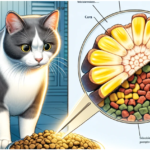Cats are curious creatures, and their adventurous nature sometimes leads to health issues, including eye infections. These infections can be uncomfortable and potentially harmful if not treated properly. Understanding the signs, causes, and treatments of common cat eye infections can help you ensure your feline friend remains in good health. Here, we explore the most common types of cat eye infections, how to recognize them, and what you can do to treat and prevent them.
What Causes Cat Eye Infections?
Eye infections in cats can be caused by a variety of factors. Bacterial and viral infections are the most common, but allergies, foreign bodies, trauma, and underlying diseases like feline herpesvirus can also lead to eye issues.
- Bacterial Infections: Bacteria like Staphylococcus and Streptococcus can infect the eyes and cause symptoms such as redness, swelling, and discharge.
- Viral Infections: The feline herpesvirus is a major culprit, often leading to recurrent eye issues in affected cats.
- Allergies: Allergens can irritate the eyes, leading to symptoms that resemble infections.
- Foreign Bodies: Dust, sand, or other small particles can get trapped in your cat’s eyes, causing irritation and infection.
- Trauma: Scratches or injuries to the eye can become infected if not treated promptly.
Conjunctivitis aka Pink Eye-the most common cat eye infections
Yes, cats can get Pink Eye, just like we do. In fact, it is the most common eye problem in cats. Pink Eye is when the conjunctiva or mucus membrane lining the inside of a cat’s eyelid and the outside of the eyeball becomes inflamed. It can have many different causes. Simple environmental irritants like dust or an allergic response to some plants can cause conjunctivitis. However, according to Cornell associate professor of ophthalmology, Thomas Kern, DVM, herpesvirus, the calicivirus, or bacterial agents, chlamydophila or mycoplasma are most commonly to blame. And cats already infected with feline immunodeficiency virus (FIV) or the feline leukemia virus (FeLV) are at a significantly increased risk of contracting Pink Eye.
If you would like more information, check out this excellent article- Cornell Feline Health Center, Conjunctivitis
Recognizing the Symptoms of Cat Eye Infections
Early detection is crucial in managing eye infections effectively. Common signs that your cat may have an eye infection include:
- Redness or swelling in or around the eye
- Watery, green, or yellow discharge
- Frequent blinking or squinting
- Pawing or rubbing at the eyes
- Sensitivity to light
- Cloudiness or change in eye color
Diagnosis and Treatment
If you suspect your cat has an eye infection, a visit to the vet is essential. The vet may perform tests such as a fluorescein stain to check for corneal injuries, a Schirmer tear test to evaluate tear production, or take samples for bacterial or viral cultures.
Treatment depends on the underlying cause of the infection:
- Antibiotics: Used for bacterial infections, available as topical ointments or drops, and sometimes oral medications.
- Antiviral Medications: Necessary for viral infections, particularly those caused by feline herpesvirus.
- Steroids and Anti-inflammatory Drugs: These can help reduce inflammation and pain, though they are used with caution.
Home Care and Prevention
While medical treatment is often necessary, there are things you can do at home to help your cat recover and prevent future infections:
- Keep the Eyes Clean: Gently wipe away discharge with a warm, damp cloth. Use a separate cloth for each eye to prevent cross-contamination.
- Administer Prescribed Medications: Ensure you follow the vet’s instructions for any medications prescribed.
- Manage Stress: Since stress can trigger outbreaks of viral infections like herpes, maintaining a calm environment can help keep your cat healthy.
- Regular Check-Ups: Routine veterinary visits can catch early signs of eye trouble before they become serious.
Conclusion
Eye infections can be a common issue in cats, but with proper knowledge and care, they can be easily managed. Recognizing the early signs of an eye infection and seeking veterinary help can prevent more serious health problems. Regular care and attention can ensure that your cat stays happy, healthy, and free of discomfort.
If you have concerns about your cat’s eyes, it’s always best to consult with a veterinarian who can provide guidance based on your cat’s specific health needs. Your care and vigilance are crucial in keeping your feline companion’s vision sharp and their eyes bright!







Rattling fantastic , I’d value it 10 10.